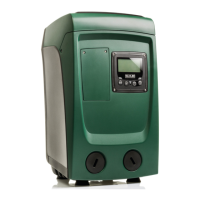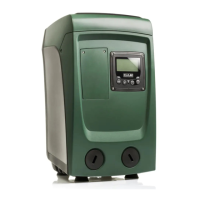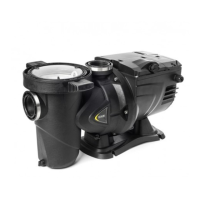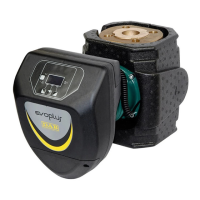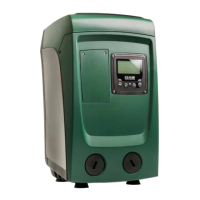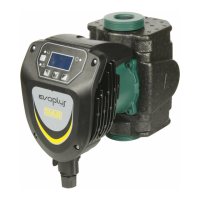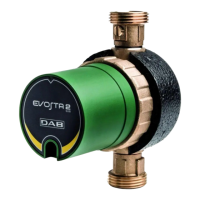ENGLISH
GB
92
LQJRU7KHPHQXDOORZV\RXWRYLHZDQGPRGLI\YDULRXVFRQ¿JXUD-
tion parameters: the MODE key allows you to scroll through the menu
pages, the + and – keys allow you respectively to increase and decrease
the value of the parameter concerned. Press SET to leave this menu and
return to the main menu.
7.6.1 - TB: Water lack blockage time
Setting the reaction time of the water lack blockage allows you to select
the time (in seconds) taken by the device to indicate the lack of water.
The variation of this parameter may be useful if there is known to be a
delay between the moment the motor is switched on and the moment it
actually begins to deliver. One example may be a plant where the suction
pipe is particularly long and there are some slight leaks. In this case the
pipe in question may be discharged and, even though water is not lack-
LQJWKHHOHFWURSXPSZLOOWDNHDFHUWDLQWLPHWRUHORDGVXSSO\WKHÀRZDQG
put the plant under pressure.
7.6.2 - T1: Low pressure delay (kiwa function)
Sets the time when the inverter switches off after receiving the low
pressure signal (see Setting low pressure detection par. 7.7.8.5). The
low pressure signal can be received on each of the 4 inputs by suitably
FRQ¿JXULQJWKHLQSXWVHH6HWXSRIDX[LOLDU\GLJLWDOLQSXWV,1,1,1
IN4 par 7.7.8).
T1 can be set between 0 and 12 s. The factory setting is 2 s.
7.6.3 - T2: Delay in switching off
Sets the delay with which the inverter must switch off after switch-off
FRQGLWLRQVKDYHEHHQUHDFKHGSODQWXQGHUSUHVVXUHDQGÀRZUDWHORZHU
WKDQWKHPLQLPXPÀRZ
T2 can be set between 2 and 120 s. The factory setting is 10 s.
*33URSRUWLRQDOJDLQFRHI¿FLHQW
Generally the proportional term must be increased for systems charac-
terised by elasticity (for example with PVC pipes) and lowered in rigid
systems (for example with iron pipes).
To keep the pressure in the system constant, the inverter performs a type
PI control on the measured pressure error. Depending on this error the
inverter calculates the power to be supplied to the motor. The behaviour
Association of devices
Pressing ‘+’ for 5 sec puts the machine into the mode where it searches
for wireless association, communicating this status by the blinking of the
icon (related to the device on which the action is carried out) and of the
COMM leds at regular intervals. As soon as two machines in a working
communication range are put into this status, if possible, they are associ-
ated with each other. If the association is not possible for one or both
machines, the procedure ends and a pop-up appears on each machine
saying “association not possible”. An association may not be possible
because the device you are trying to associate is already present in the
maximum number or because the device to be associated is not recog-
nised.
The search status for association remains active until the device to be
associated is detected (irrespective of the result of association); if not
device can be seen within the space of 1 minutes, the machine automati-
cally leaves association status. You can leave the search status for wire-
less association at any time by pressing SET or MODE.
Disassociation of devices
7RGLVDVVRFLDWHDQHOHPHQW\RXPXVW¿UVWVHOHFWLWZLWKWKH³´RU³´NH\V
then press - for 5 s; this puts the system into device disassociation mode
LQZKLFKWKHLFRQRIWKHVHOHFWHGGHYLFHDQGWKH&200OHGVWDUWWRÀDVK
rapidly, indicating that the device chosen will be cancelled. The next time
- is pressed the device will be disassociated; instead, if you press any key
or let more than 30 sec elapse from entering disassociation mode, the
procedure will be terminated.
7.5.6 - PR: Remote pressure sensor
Setting of the type of remote pressure sensor.
7.6 - Technical Assistance Menu
Advanced settings to be made only by skilled personnel or under the
direct control of the service network.
From the main menu, hold down simultaneously the “MODE” and “SET”
keys until “SP” appears on the display (or use the selection menu press-
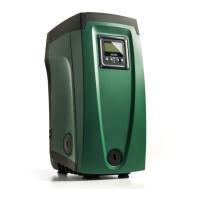
